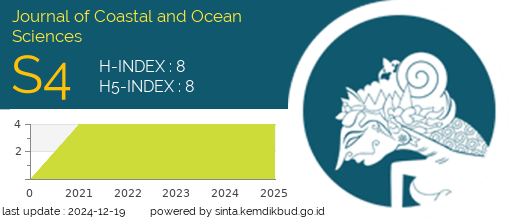Short Communication: Structure Community of Mangrove in Peunaga Rayeuk Area, Meurebo District, Aceh West
DOI:
https://doi.org/10.31258/Keywords:
Meurebo, Mangroves, Community structureAbstract
This study aims to determine the structure of the mangrove community on the coast of Peunaga Rayeuk, Meurebo District, and West Aceh District. The method used in this study was line transect, making transects/plots for each observation station with a size of 10x10 m2 with 3 replications so that each observation station has an area of 30x10 m2. This research was conducted in October 2022. There were 2 types of mangroves included in the observation station, namely Rhizophora apiculata and Avicennia alba, while the associated mangrove was of the type Acrostichum speciosum. In addition, there are also associated mangroves that are not included in the observation station but are located around the observation station, namely Nypa fruticans, Hibiscus tiliaceus, and Pandanus odoratissima. Stations 1 and 2 were dominated by sandy and muddy sand substrates, which respectively showed a diversity index of 0.054 and 0.149, a uniformity index of 0.078 and 0.215, and a dominance of 0.478 and 0.252. The most abundant species was R.apiculata with a relative density of 0.949 ind/ha, followed by S.alba of 0.051. Relative cover of R.apiculata and S.alba respectively with the range of 0.302 and 0.698. The results of this study concluded that over all the structure of the mangrove community on the coast of Peunaga Rayeuk is still classified as low, so it requires greater attention in the restoration and management of mangrove ecosystems
Downloads
References
Ashton, E.C., & Macintosh, D.J. (2002). Preliminary assessment of the plant diversity and community ecology of the Sematan mangrove forest , Sarawak , Malaysia. 166.
Bengen, D.G. (2004). Ekosistem dan Sumberdaya Alam Pesisir dan Laut serta Prinsip Pengelolaannya. Bogor : Pusat Kajian Sumberdaya Pesisir dan Laut, Institut Pertanian Bogor
Dharmawan, I.W.E. (2021). Mangrove Health Index Distribution on the Restored Post-Tsunami Mangrove Area in Biak Island, Indonesia. IOP Conference Series: Earth and Environmental Science, 860(1). https://doi.org/10.1088/1755-1315/860/1/012007
Dharmawan, I.W.E., & Pramudji. (2017). Panduan pemantauan komunitas mangrove. In Critc Coremap Cti Lipi (Issue 2).
Giesen, W., Wulffraat, S., Zieren, M., & Scholten, L. (2006). Mangrove Guidebook.
Gilman, E.L., Ellison, J., Duke, N.C., Field, C. (2008). Threats to Mangroves from Climate Change and Adaptation Options: A review. Aquatic Botany, 89(2), 237–250. https://doi.org/10.1016/j.aquabot.2007.12.009
Giri, C., Ochieng, E., Tieszen, L.L., Zhu, Z., Singh, A., Loveland, T., Masek, J., Duke, N. (2011). Status and Distribution of Mangrove Forests of the World using Earth Observation Satellite Data. Global Ecology and Biogeography, 20: 154-159
Kon, K., Kurokura, H., Tongnunui. (2010). Effect of the Physical Structure of Mangrove Vegetation on a Benthic Faunal Community. Journal of Experimental Marine Biology and Ecology, 282(2): 171-180. https://doi.org/10.1016/j.jembe.2009.11.015
Lewis, R.R., Milbrandt, E.C., Brown, B., Krauss, K.W., Rovai, A.S., Beever, J.W., Flynn, L.L. (2016). Stress in Mangrove Forests: Early Detection and Preemptive Rehabilitation are Essential for Future Successful Worldwide Mangrove Forest Management. Marine Pollution Bulletin, 109(2), 764–771. https://doi.org/10.1016/j.marpolbul.2016.03.006
Nehru, P., & Balasubramanian, P. (2018). Mangrove Species Diversity and Composition in the Successional Habitats of Nicobar Islands, India: A Post-Tsunami and Subsidence Scenario. Forest Ecology and Management, 427: 70–77. https://doi.org/10.1016/j.foreco.2018.05.063
Shannon, C.E., & Weaver, W. (1949). The Mathematical Theory of Communication.
Sippo, J.Z., Lovelock, C.E., Santos, I.R., Sanders, C.J., Maher, D.T. (2018). Mangrove Mortality in a Changing Climate: An overview. Estuarine, Coastal and Shelf Science, 215:241–249. https://doi.org/10.1016/j.ecss.2018.10.011
Soegianto, A. (1994). Ekologi kuantitatif : metode analisis populasi dan komunitas. Surabaya: Usaha Nasional.
UNEP (2011). Keeping Track of Our Changing Environment: From Rio to Rio+20 (1992-2012). Division of Early Warning and Assessment (DEWA), United Nations Environment Programme (UNEP), Nairobi.






